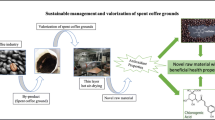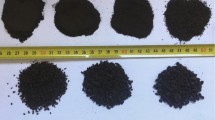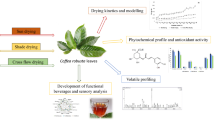Abstract
The aim of this study was to study the convective drying of the hydroalcoholic extracts obtained from powdered guarana seeds in a spouted bed dryer. The influence of process variables, such as the convective airflow rate, extract feed rate, and air inlet temperature, on the quality of the dry extract was determined using the caffeine and moisture content for the process evaluation. The caffeine content in the alcoholic and dried extracts was determined by capillary gas chromatography. The experiments were performed following a 33 factorial design and the data analyzed by response surface. The analysis of dry extract showed that the air and extract feed rates did not significantly affect (25% level) the caffeine content, but that drying temperature is a major factor to consider when the extract is submitted to fluid bed drying. Caffeine losses were significant (1% level) for drying temperatures above 120°C, while moisture content was lower than 3% for temperatures above 120°C. The data showed that there is an optimum temperature for the drying of guarana extracts in spouted beds, and under the conditions used in this study it was 120°C.
Similar content being viewed by others
References
Casadebaig J, Jacob M, Cassanas G, Gaudy D, Puech A. Physicochemical and pharmacological properties of spray dried powders from Fraxinus excelsior leaf extracts. J Ethnopharmacol. 1989;26: 211–216.
da Fonseca CA, Leal J, Costa SS, Leitao AC. Genotoxic and mutagenic effects of guarana (Paullinia cupana) in prokaryotic organisms. Mutat Res. 1994;321:165–173.
Duke JA. CRC Handbook of Medicinial Herbs. Boca Raton, FL: CRC Press; 1985.
Todafruta. Brazilian guarana becomes international commodity [in Portuguese]. Available at: http://www.todafruta.com.br. Accessed: January 31, 2005.
Bempong DK, Houghton PJ. Dissolution and absorption of caffeine from guarana. J Pharm Pharmacol. 1992;44:769–771.
Salvadori MC, Rieser EM, Neto LMR. Nascimento ES. Determination of xanthines by high performance liquid chromatography and thin layer chromatography in horse urine after ingestion of guarana powders. Analyst. 1994;119:2701–2703.
Eteng MU, Eyong EU, Akpanyung ED, Agiang MA, Aremu CY. Recent advances in caffeine and theobromine toxicities: a review. Plant Foods Hum Nutr. 1997;51:231–243.
List PH, Schmidt PC. Phytopharmaceutical Technology. Boca Raton, FL: CRC Press; 1989.
Craig DQM, Royall PG, Kett VL, Hopton ML. The relevance of the amorphous state to pharmaceutical dosage forms: glassy drugs and freeze dried systems. Int J Pharm. 1999;179:179–207.
Bhandari BR, Howes T. Implication of glass transition for the drying and stability of dried foods. J Food Eng. 1999;40:71–79.
Broadhead J, Rouan SKE, Rhodes CT. The spray drying of pharmaceuticals. Drug Dev Ind Pharm. 1992;18:1169–1206.
Strumillo C, Markowski A, Kaminsky W. Modern developments in drying of pastelike materials. In: Mujumdar AS, ed.. Advances in Drying, Vol 2, New York: Hemisphere; 1983: 193–232.
Pagliarussi RS. Production of Guarana (Paullina Cupana) Dry Extract: Influence of Extraction and Drying Processes on Caffeine Content [MSc dissertation]. São Paulo, Brazil: University of São Paulo, Brazil; 1999.
Pagliarussi RS, Freitas LAP, Bastos JK. A quantitative method for the analysis of xanthine alkaloids in Paullinia cupana (guarana) by capillary column gas chromatography. J Sep Sci. 2002;25: 371–374.
Epstein N, Grace JR. Spouting of particulate solids. In: Fayed ME, Otten L, eds. Handbook of Powder Science & Technology. New York, NY: Chapman & Hall; 1997: 532–567.
Freitas LAP, Bastos JK, Pagliarussi RS. Heat and mass transfer during the drying of guarana extracts in spouted beds. In: Mujumdar AS, ed. IDS’98. Halkidiki, Greece: Ziti Editions; 1998: 1786–1793.
Patty FA. Industrial Hygiene and Toxicology. Vol 1. New York: Interscience Publishers: 1958.
Berthold W, Loffler U. Safety characteristics and their significance for the design and operation of chemical plants. Int J Chem Eng. 1993; 33:178–183.
Myers MH. Response Surface Methodology. Boston: Allyn & Bacon; 1971.
Box MJ, Hunter WG, Hunter JS. Statistics for Experimenters: An Introduction to Design, Data Analysis and Model Building. New York, NY: John Wiley & Sons; 1978.
Author information
Authors and Affiliations
Corresponding author
Additional information
Published: June 16, 2006
Rights and permissions
About this article
Cite this article
Pagliarussi, R.S., Bastos, J.K. & Freitas, L.A.P. Fluid bed drying of guarana (Paullinia cupana HBK) extract: Effect of process factors on caffeine content. AAPS PharmSciTech 7, 54 (2006). https://doi.org/10.1208/pt070254
Received:
Accepted:
DOI: https://doi.org/10.1208/pt070254




